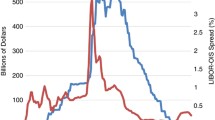Abstract
This study provides findings on the transmission of liquidity shocks by Austrian parent banks through the lending channel. The paper investigates how different types of banks adjust their balance sheet positions in response to a liquidity shock. It distinguishes between different definitions of lending activities, such as changes in domestic C&I lending, foreign C&I lending, total credit, cross-border claims, foreign offices local claims, and internal borrowing between affiliated banks. The paper finds that (1) smaller banks (parent banks without affiliates) response to liquidity risk depends on core deposit funding for foreign C&I lending and total credit. (2) Cross-sectional differences in large banks (parent banks with affiliates) in response to liquidity risk cannot be uniformly explained by one particular ex ante determinant. The growth of cross-border claims is negatively correlated with a higher share of illiquid assets and with a higher share of capital, and positively correlated with the commitment ratio. Use of official sector liquidity provided by the Austrian government reduces the importance of the commitments share as a driver of cross-sectional differences in lending by Austrian global banks in response to market liquidity risks.

Similar content being viewed by others
Notes
For a general overview of statistical evidence concerning the Austrian banking sector, see Statistik (2011).
See EZB Monetaer Statistik Regulation (EC) No 25/2009 EZB-MONSTAT. Data reports based on the Directive 2006/48/EC of the European Parliament and of the Council.
The OeNB determines once a year during the data collection process for EZB-MONSTAT report, which financial institutions need to report according to the Cutting-Off-The-Tail principle.
The starting date of the data set corresponds to a change in the reporting criteria Monetaer Statistik—Ausweisrichtlinie, Beleg 23, V 0413.pdf; Abschnitt: Version 2.0 April 2004.
For a more detailed description of the EZB bank lending survey, see Beer and Waschiczek (2012).
The slump in 2007 is due to a slowdown in foreign lending for several, smaller banks in the Western region of Austria, near foreign borders to Switzerland, Germany, and Italy.
For more information on deleveraging in Europe and Austria, see Eidenberger, Schmitz, and Steiner (2014).
For more information on the importance of destination countries, see Segalla (2014).
The mean bank without foreign affiliates has an asset sum of €2 billion, the mean bank with foreign affiliates is 4.5 times larger.
For an overview of the Vienna Initiative and its impact on host countries, see De Haas and others (2015).
References
Beer, C. and W. Waschiczek, 2012, “Analyzing Corporate Loan Growth in Austria Using Bank Lending Survey Data Conceptual Issues and Some Empirical Evidence,” Monetary Policy and the Economy OeNB, No. 2, pp. 61–80.
Bericht des Rechnungshofes. 2012/9, Bankenpaket.
Buch, C. and L. Goldberg, 2015, “International Banking and Liquidity Risk Transmission: Lessons from Across Countries,” IMF Economic Review, Vol. 63, No. 3, pp. 377–410.
De Haas, R., Y. Korniyenko, A. Pivovarsky, and T. Tsankova, 2015, “Taming the Herd? Foreign Banks, the Vienna Initiative and Crisis Transmission,” Journal of Financial Intermediation, Vol. 24, No. 3, pp. 325–355.
Eidenberger, J., S.W. Schmitz, and K. Steiner, 2014, The Priorities of Deleveraging in the Euro Area and Austria and its Implications for CESEE, Financial Stability Report, No. 27, June.
Hameter, M., M. Lahnsteiner, and U. Vogel, 2012, Intra-Group Cross-Border Credit and Roll-Over Risks in Cesee—Evidence from Austrian Banks, Financial Stability Report, No. 23, pp. 76–93.
Puhr, C., M.S. Schwaiger, and M. Sigmund, 2009, Direct Cross-Border Lending by Austrian Banks to Eastern Europe, Financial Stability Report, No. 17, pp. 61–80.
Segalla, E., 2014, “Shock Transmission through International Banks: Austria,” Oesterreichische Nationalbank Working Paper Series (199).
Segalla, E., 2015, When Austrian Banks Cross Borders, Financial Stability Report, No. 29, pp. 110–21.
Oesterreichische Nationalbank Statistik. 2011, Bankenstatistisches Jahrbuch.
Additional information
*Esther Segalla is a research economist at the Economic Studies Division of the Oesterreichische Nationalbank. Esther received a Master of Advanced Studies from Pompeu Fabra University, Spain and a Ph.D. in Economics from the University of Vienna, Austria. This paper has been written within the framework of IBRN and the author gratefully acknowledges the support from its members. The analysis has benefited from helpful suggestions and discussions with Helmut Elsinger, Pirmin Fessler, Markus Knell, Andreas Schicho, Helmut Stix, and Michael Strommer. The author thanks Thomas Bergmair, Simona Jokubauskaite, and Daniela Michel for excellent research assistance.
An erratum to this article is available at http://dx.doi.org/10.1057/s41308-017-0034-4.




